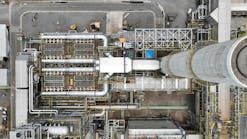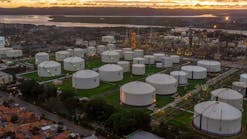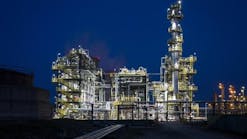India grants environmental clearance for NRL’s Numaligarh refinery expansion project
India's Ministry of Environment, Forest & Climate Change (EFCC) has approved Numaligarh Refinery Ltd.’s previously announced project for the expansion of its 3-million tonnes/year Numaligarh refinery at Village Pankagrant in the Brahmaputra valley of Assam’s Golaghat district in India (OGJ Online, Jan. 16, 2019; Sept. 21, 2012).
EFCC granted official environmental clearance for the project—which will increase overall crude oil processing capacity at Numaligarh by 6 million tpy to 9 million tpy—to proceed on July 27, NRL said on Aug. 10 at its 27th annual general meeting.
The refinery’s proposed expansion is one of three major projects on which the company is currently focused, the other two of which include the 130-km Indo-Bangla Friendship Pipeline (IBFPL) for transporting Numaligarh refinery’s products from the Siliguri marketing terminal to Bangladesh, as well as India’s first 2G bamboo biomass-based biorefinery—under joint execution by Assam Bio-Refinery Pvt. Ltd., a joint venture of NRL (50%) and partners Fortum Corp. of the Netherlands (25%) and Chempolis Ltd. of Findland—that will process 300,000 tpy of dry bamboo (500,000 tpy of green bamboo)—to produce about 49,000 tpy of bioethanol, 11,000 tpy of acetic acid, and 18,000 tpy of furfural alcohol, NRL told investors
Work on the three projects continues to progress under stringent monitoring despite lockdowns, travel restrictions, logistic disruptions, and migrant-worker availability resulting from the coronavirus (COVID-19) health crisis to ensure scheduled completion and commissioning of the projects, said S.K. Barua, NRL’s managing director.
In reviewing the company’s annual performance for the fiscal year (FY) 2019-20 ended Mar. 31, 2020, NRL confirmed the Numaligarh refinery processed 2.383 million tpy of crude, falling short of its 2.8-million tpy target due to extension of a major turnaround for unforeseen reasons in December 2019 as well as demand destruction caused by the COVID-19 outbreak during March 2020.
The refinery also processed Malaysian Miri Light crude oil for the first time in FY 2019-20, the operator confirmed.
Numaligarh expansion
Officially approved by India’s Cabinet Committee on Economic Affairs in January 2019, the planned 225.94 billion-rupee Numaligarh expansion—which also will include construction of a 180,750-b/d, 1,398-km crude pipeline from Paradip to Numaligarh, as well as a 120,500-b/d, 654-km products pipeline from Numaligarh to Siliguri—subsequently required an additional investment of 41.65 billion rupees to complete for a revised overall project cost of 267.59 billion rupees (OGJ Online, May 7, 2020).
According to a February 2020 environmental impact assessment for the refinery’s expansion completed by Engineers India Ltd. (EIL), the project—which will involve construction of a new refining unit at the site designed to process imported sour crudes—will add the following major units and capacities at Numaligarh:
- Combined crude-vacuum distillation unit (with naphtha stabilizer); 6 million tpy.
- Naphtha hydrotreating unit; 1.2 million tpy.
- Continuous catalytic reforming (CCR) unit; 750,000 tpy.
- Naphtha isomerization unit; 500,000 tpy.
- Petrochemical fluidized catalytic cracking (PFCC) unit; 1.95 million tpy.
- FCC gasoline hydrotreating (desulfurization) unit; 580,000 tpy.
- Diesel hydrotreating unit; 3.55 million tpy.
- Hydrogen generation unit; 95,000 tpy.
- Residue upgrading unit (ebulated bed, with vacuum gas oil hydrotreater); 2 million tpy.
- LPG treating unit; unavailable.
- Fuel gas treating unit; unavailable.
- Sour-water stripping unit; unavailable.
- Amine regeneration unit; unavailable.
- Sulfur recovery unit, tail-gas treatment unit; 230,000 tpy each.
The project additionally will involve a revamp of the refinery’s existing 300,000-tpy delayed coking unit to increase its processing capacity to 570,000 tpy.
According to EFCC’s July 27, 2020, environmental clearance for the project to proceed, the expansion will increase the refinery’s current production capacities—including volumes of products purchased outside the refinery—as follows:
- 66,000 tpy of LPG by 500,000 tpy to 566,000 tpy.
- 80,000 tpy of coke by 245,000 tpy to 325,000 tpy.
- 360,000 tpy of Bharat Stage VI (BS-VI, equivalent to Euro 6) motor spirit (MS; gasoline) by 1.572 million tpy to 1.932 million tpy.
- 2.236 million tpy of BS VI high-speed diesel (HSD) by 3.370 million tpy to 5.606 million tpy.
- 6,000 tpy of sulfur by 145,000 tpy to 151,000 tpy.
NRL’s owners include Bharat Petroleum Corp. Ltd. 61.65%, Oil India Ltd. 26%, and the government of Assam 12.35%.

Robert Brelsford | Downstream Editor
Robert Brelsford joined Oil & Gas Journal in October 2013 as downstream technology editor after 8 years as a crude oil price and news reporter on spot crude transactions at the US Gulf Coast, West Coast, Canadian, and Latin American markets. He holds a BA (2000) in English from Rice University and an MS (2003) in education and social policy from Northwestern University.



